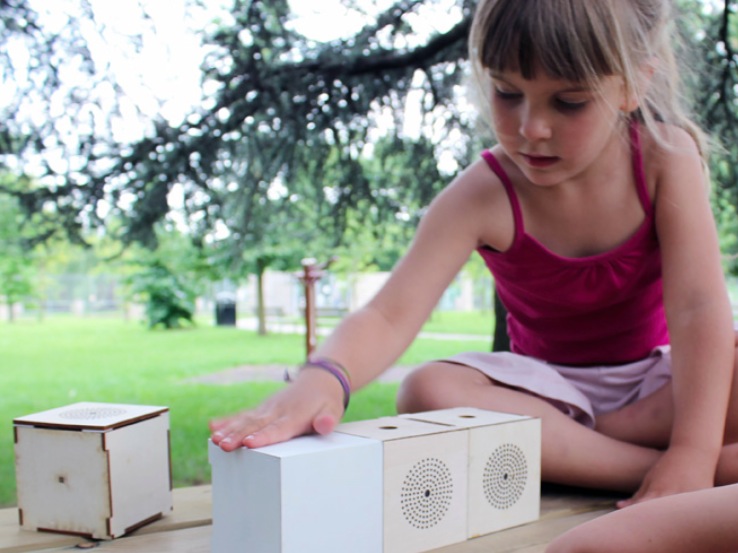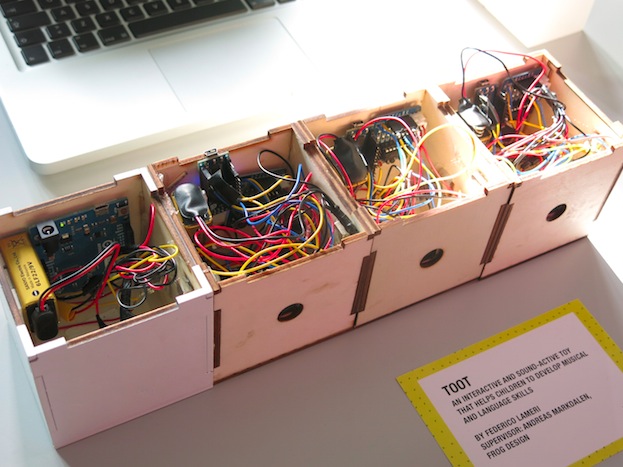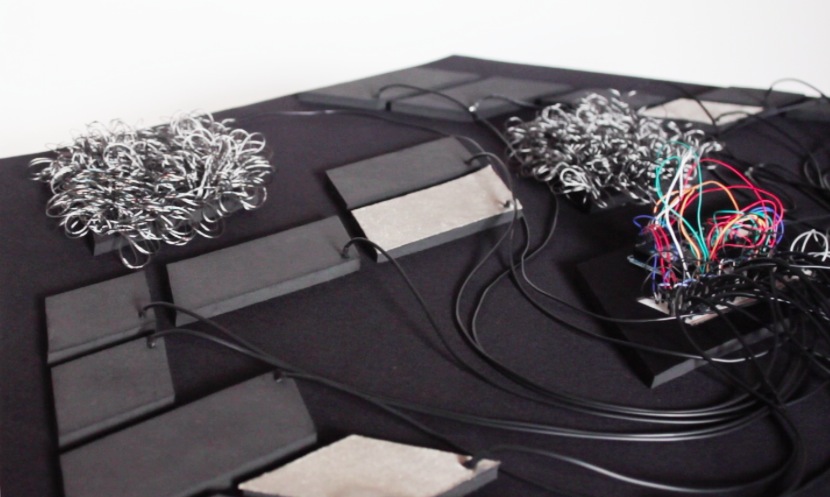Posts with «sound» label
Experience sound multi-sensorially with Ocho Tonos
Some of you may have noticed that words like rhythm, texture, pattern, can be used both to describe fabrics, as well as sound. Focused on building an interface as a whole, using mostly textiles, OCHO TONOS invites the user to interact through touch, and experience sound in a multi-sensorial way. Ocho Tonos is an interactive installation by EJTech duo (Esteban de la Torre and Judit Eszter Kárpáti) I met last July during etextile summer camp while they were working on this experimental textile interface for tactile/sonic interaction by means of tangibles:
Exploring the relation between sound and textile and experimenting with the boundaries of our senses whilst changing the way we perceive fabric, surfaces and their manifestation as sound. Recontextualizing our tactile interaction with textile acting as an interface, where each element triggers, affects and modifies the generated sound’s properties. Creating a soundscape through sensor technology enticing audiophiles to interact and explore with reactive textile elements.The nexus of the body, the senses and technology.
OCHO TONOS is a symbiosis of the unique hand-crafted traditional textile techniques and the immaterial digital media.
Thanks to Arduino Mega ADK , all inputs coming from the touch of the user on the soft sensors are translated into a digital platform, parsed and filtered through MaxMSP, in order to control the generation of a soundscape in Ableton Live.
Ocho Tonos was chopped, spiced and cooked at Kitchen Budapest. Sounds used are samples from the working machinery at TextielLab.
Music and language skills get a boost with Toot

Toot is an interactive and sound-active toy designed for children aged between 3 and 6 years old that wants to enhance their auditory, music and language skills. It was developed by Federico Lameri as his thesis project of Master of Interaction Design at Supsi and prototyped using Arduino Leonardo.
The toy is composed by eight little cubical speaker boxes:
On each speaker children are able to record a sound. In order to listen back to the recorded sound the speaker must be shaken as if the sound was physically trapped into a box. After having recorded sounds on them, the speakers can be placed in a sequence after Mr.toot, and by tapping on his head it is possible to trigger the playback of the speakers in a sequence. toot is also matched with a mobile application that offers different kind of interactions and experiences. it allows to play some exercise that will teach children to listen, understand and catalog sound and melodies.

The app expands the possibilities of interaction, offering different exercises created with the help of musicians and educators from different areas of expertise, some of them are also inspired by a Montessori sensorial activity.
Take a look at the video interview with Montessori educator Fanny Bissa:
Old Kit Review – Diesel Sound Simulator for Model Railroads
Introduction
In this review of an older kit (circa 1993~1997) we examine the Diesel Sound Simulator for Model Railroads kit from (the now defunct) Dick Smith Electronics, based on the article published in the December 1992 issue of Silicon Chip magazine.
The purpose of this kit is to give you a small circuit which can fit in a HO scale (or larger) locomotive, or hidden underneath the layout – that can emulate the rumbling of a diesel-electric locomotive to increase the realism of a train. However the kit is designed for use with a PWM train controller (also devised by Silicon Chip!) so not for the simple direct-DC drive layouts.
Assembly
The diesel sound kit was from the time when DSE still cared about kits, so you received the sixteen page “Guide to Kit Construction” plus the kit instructions, nasty red disclaimer sheet, feedback card, plus all the required components and the obligatory coil of solder that was usually rubbish:
Everything required to get going is included, except IC sockets. My theory is it’s cheaper to use your own sockets than source older CMOS/TTL later on if you want to reuse the ICs, so sockets are now mandatory here:
The PCB is from the old school of “figure-it-out-yourself”, no fancy silk-screening here:
Notice the five horizontal pads between the two ICs – these were for wire bridges in case you needed to break the PCB in two to fit inside your locomotive.
Actual assembly was straight-forward, all the components went in without any issues. Having two links under IC2 was a little annoying, however a short while later the PCB was finished and the speaker attached:
How it works
As mentioned earlier this diesel sound kit was designed for use with the Silicon Chip train PWM controller, so the design is a little different than expected. It can handle a voltage of around 20 V, and the sound is determined by the speed of the locomotive.
The speed is determined by the back EMF measured from the motor – and (from the manual) this is the voltage produced by the motor which opposes the current flow through it and this voltage is directly proportional to speed.
Not having a 20V DC PWM supply laying about I knocked up an Arduino to PWM a 20V DC supply via an N-MOSFET module and experimented with the duty cycle to see what sort of noises could be possible. The output was affected somewhat by the supply voltage, however seemed a little higher in pitch than expected.
You can listen to the results in the following video:
I reckon the sound from around the twenty second mark isn’t a bad idle noise, however in general not that great. The results will ultimately be a function of a lower duty-cycle than I could create at the time and the values of R1 and R2 used in the kit.
Conclusion
Another kit review over. With some time spent experimenting you could generate the required diesel sounds, a Paxman-Valenta it isn’t… but it was a fun kit and I’m sure it was well-received at the time. To those who have been asking me privately, no I don’t have a secret line to some underground warehouse of old kits – just keep an eye out on ebay and they pop up now and again. Full-sized images and much more information about the kit are available on flickr.
And while you’re here – are you interested in Arduino? Check out my new book “Arduino Workshop” from No Starch Press.
In the meanwhile have fun and keep checking into tronixstuff.com. Why not follow things on twitter, Google+, subscribe for email updates or RSS using the links on the right-hand column? And join our friendly Google Group – dedicated to the projects and related items on this website. Sign up – it’s free, helpful to each other – and we can all learn something.
The post Old Kit Review – Diesel Sound Simulator for Model Railroads appeared first on tronixstuff.
Sunny the RFID lion
What does it do?
This is a copy of the RFID bear on Make. I have however added a few new features in the code like a ram check, a random file player and a sound response. The random file player I adds another dimension to the character. If you would like to make you own it is very easy.











